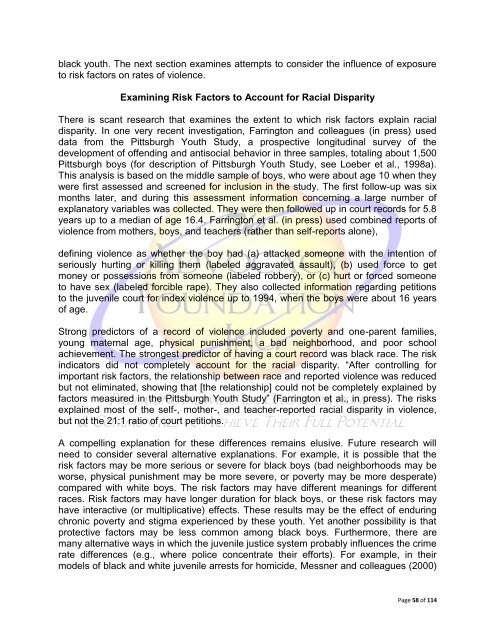African-American Youth in The Juvenile Justice System
African-American Youth in The Juvenile Justice System
African-American Youth in The Juvenile Justice System
Create successful ePaper yourself
Turn your PDF publications into a flip-book with our unique Google optimized e-Paper software.
lack youth. <strong>The</strong> next section exam<strong>in</strong>es attempts to consider the <strong>in</strong>fluence of exposure<br />
to risk factors on rates of violence.<br />
Exam<strong>in</strong><strong>in</strong>g Risk Factors to Account for Racial Disparity<br />
<strong>The</strong>re is scant research that exam<strong>in</strong>es the extent to which risk factors expla<strong>in</strong> racial<br />
disparity. In one very recent <strong>in</strong>vestigation, Farr<strong>in</strong>gton and colleagues (<strong>in</strong> press) used<br />
data from the Pittsburgh <strong>Youth</strong> Study, a prospective longitud<strong>in</strong>al survey of the<br />
development of offend<strong>in</strong>g and antisocial behavior <strong>in</strong> three samples, total<strong>in</strong>g about 1,500<br />
Pittsburgh boys (for description of Pittsburgh <strong>Youth</strong> Study, see Loeber et al., 1998a).<br />
This analysis is based on the middle sample of boys, who were about age 10 when they<br />
were first assessed and screened for <strong>in</strong>clusion <strong>in</strong> the study. <strong>The</strong> first follow-up was six<br />
months later, and dur<strong>in</strong>g this assessment <strong>in</strong>formation concern<strong>in</strong>g a large number of<br />
explanatory variables was collected. <strong>The</strong>y were then followed up <strong>in</strong> court records for 5.8<br />
years up to a median of age 16.4. Farr<strong>in</strong>gton et al. (<strong>in</strong> press) used comb<strong>in</strong>ed reports of<br />
violence from mothers, boys, and teachers (rather than self-reports alone),<br />
def<strong>in</strong><strong>in</strong>g violence as whether the boy had (a) attacked someone with the <strong>in</strong>tention of<br />
seriously hurt<strong>in</strong>g or kill<strong>in</strong>g them (labeled aggravated assault), (b) used force to get<br />
money or possessions from someone (labeled robbery), or (c) hurt or forced someone<br />
to have sex (labeled forcible rape). <strong>The</strong>y also collected <strong>in</strong>formation regard<strong>in</strong>g petitions<br />
to the juvenile court for <strong>in</strong>dex violence up to 1994, when the boys were about 16 years<br />
of age.<br />
Strong predictors of a record of violence <strong>in</strong>cluded poverty and one-parent families,<br />
young maternal age, physical punishment, a bad neighborhood, and poor school<br />
achievement. <strong>The</strong> strongest predictor of hav<strong>in</strong>g a court record was black race. <strong>The</strong> risk<br />
<strong>in</strong>dicators did not completely account for the racial disparity. “After controll<strong>in</strong>g for<br />
important risk factors, the relationship between race and reported violence was reduced<br />
but not elim<strong>in</strong>ated, show<strong>in</strong>g that [the relationship] could not be completely expla<strong>in</strong>ed by<br />
factors measured <strong>in</strong> the Pittsburgh <strong>Youth</strong> Study” (Farr<strong>in</strong>gton et al., <strong>in</strong> press). <strong>The</strong> risks<br />
expla<strong>in</strong>ed most of the self-, mother-, and teacher-reported racial disparity <strong>in</strong> violence,<br />
but not the 21:1 ratio of court petitions.<br />
A compell<strong>in</strong>g explanation for these differences rema<strong>in</strong>s elusive. Future research will<br />
need to consider several alternative explanations. For example, it is possible that the<br />
risk factors may be more serious or severe for black boys (bad neighborhoods may be<br />
worse, physical punishment may be more severe, or poverty may be more desperate)<br />
compared with white boys. <strong>The</strong> risk factors may have different mean<strong>in</strong>gs for different<br />
races. Risk factors may have longer duration for black boys, or these risk factors may<br />
have <strong>in</strong>teractive (or multiplicative) effects. <strong>The</strong>se results may be the effect of endur<strong>in</strong>g<br />
chronic poverty and stigma experienced by these youth. Yet another possibility is that<br />
protective factors may be less common among black boys. Furthermore, there are<br />
many alternative ways <strong>in</strong> which the juvenile justice system probably <strong>in</strong>fluences the crime<br />
rate differences (e.g., where police concentrate their efforts). For example, <strong>in</strong> their<br />
models of black and white juvenile arrests for homicide, Messner and colleagues (2000)<br />
Page 58 of 114

















